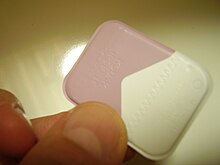X-ray film
An X-ray film is a photographic film optimized for recording with X-rays . In contrast to normal films, for the purpose of better radiation absorption, it is coated on both sides with photographic emulsions , for example based on silver bromide with an ordered silver crystal structure. Polyester is usually used as the carrier material .
X-ray films are available in standardized sizes as light-tight packaged formats or rolls. Formats (sheets) are usually used for cassettes that seal the film light-tight for recording. Roles serve u. a. the testing of pipe welds. X-ray films are also available shrink-wrapped together with X-ray intensifying screens . This saves the handling of the cassettes. X-ray films for conventional radiology are available in different sizes:
- 13 × 18 cm
- 18 × 24 cm
- 18 × 43 cm
- 20 × 40 cm
- 24 × 30 cm
- 30 × 40 cm
- 35 x 35 cm (14 x 14 inches) e.g. B. for lung x-rays
- 35 x 43 cm (14 x 17 inches) e.g. B. for lung x-rays
- 8 × 10 in
- 10 × 12 in
In dentistry , enoral X-ray films (dental films) are available in the formats 2 × 3 cm (children), 3 × 4 cm (standard size), 4 × 5 cm, 6 × 8 cm and 2.5 × 5 cm ( bitewing image ) .
X-rays are increasingly being digitized. Instead of exposing a dental film, the image information is passed on to the PC via electrical signals and digitally archived (see Picture Archiving and Communication System (PACS) and Digital Imaging and Communications in Medicine (DICOM)), which means that X-ray films are increasingly being displaced.
